All images © Frederic Marschall. Please ask for permission if you would like to use any of them.
.
THE WORLD SHAKUHACHI FESTIVAL 2018
tales and lessons
Adrian Freedman , Shimura Zenpo and Okuda Atsuya.
Kaoru Kakizakai, Furuya Teruo, Kurahashi Yodo II.
Tanabe Shozan, Fujiyoshi Etsuzan, Ishikawa Toshimitsu.
Riley Lee, two concerts
Nomura Hozan, Kuroda Reison, Akihito Obama and John Kaizan Neptune.
Yuko Hagioka, Akihito Obama
Kikuchi Naoko, Ishikawa Toshimitsu.
Miazaki Mieko twice and Kawamura Kizan
Kikuchi Naoko and Kuniyoshi Sugawara twice.
The illustrations you will see in the article were all made at the festival and subsequently colored.
Rather than accurately depicting the concerts, I've recomposed the players together to give you a sense of the atmosphere.
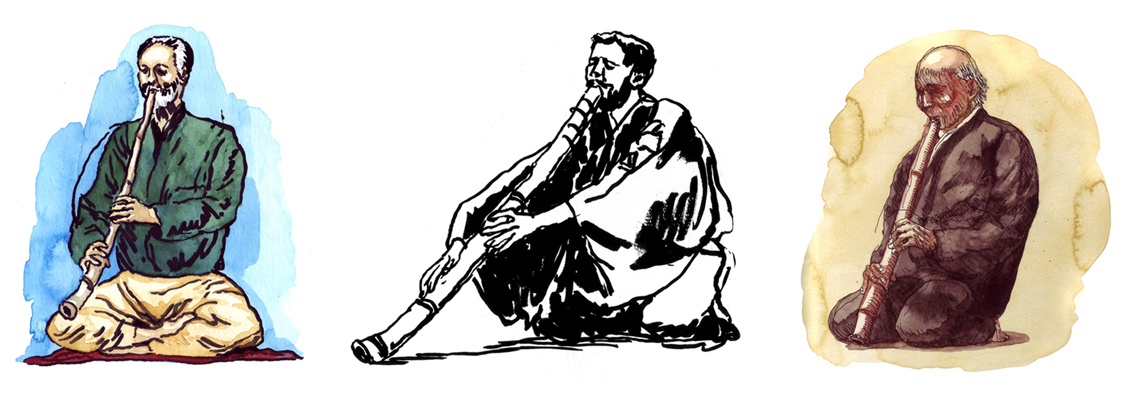
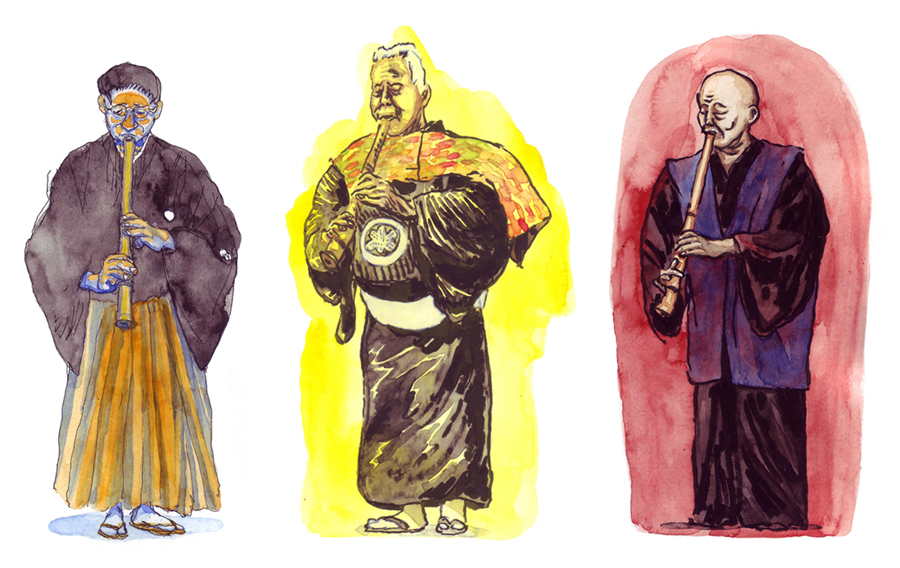
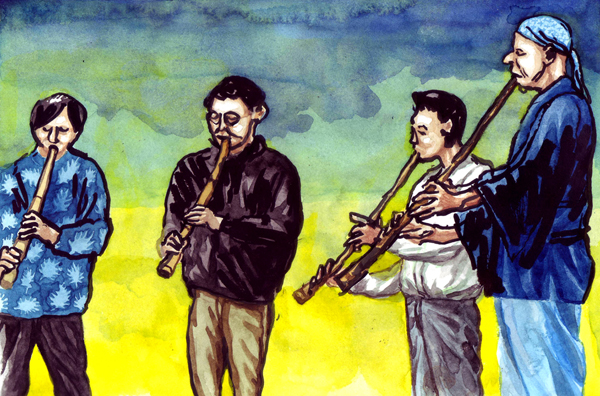
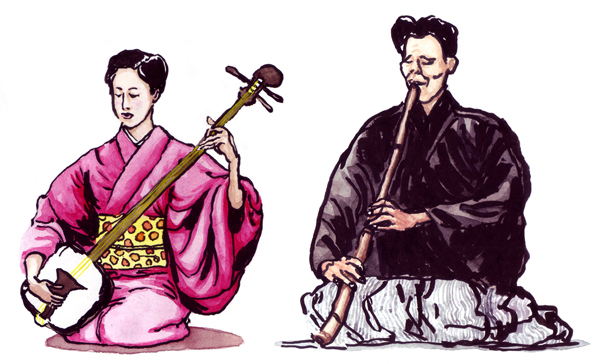
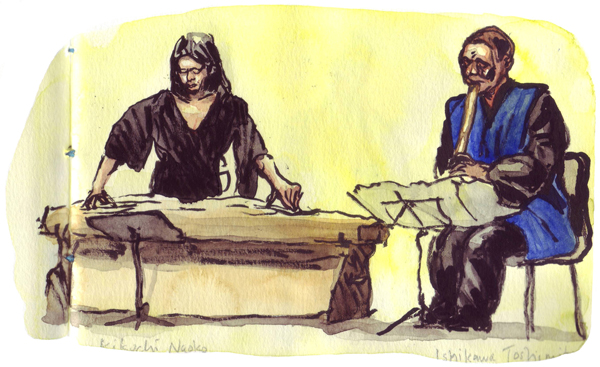
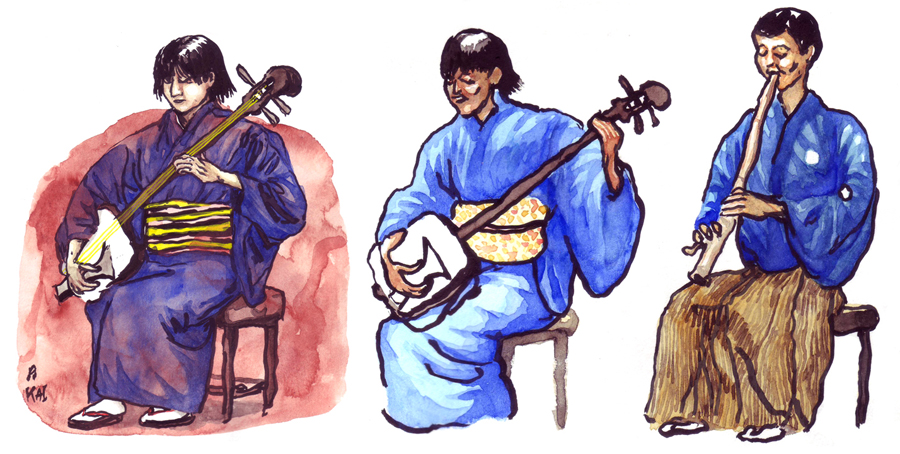
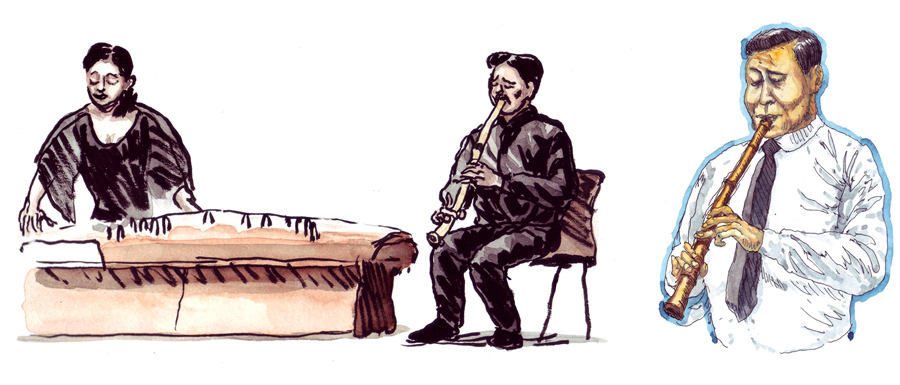
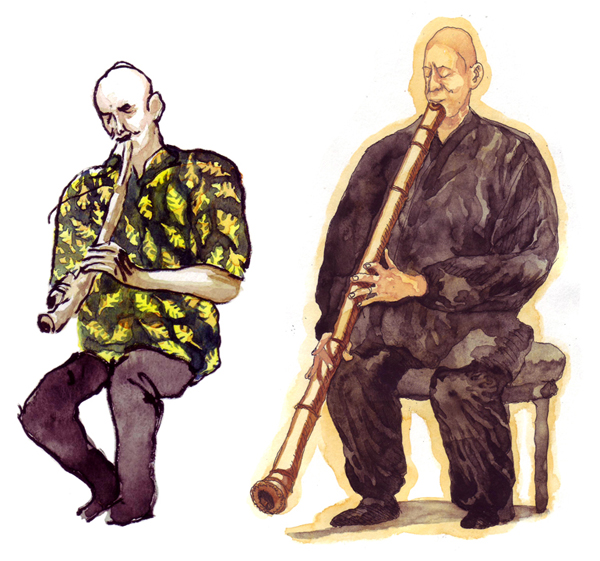
As the last day dawned on us, preparations were being made for the finale concert while we were enjoying our workshops and lectures. At this point I was saturated with knowledge and fatigue was exasperated by the intense heat that hung over London that week.
The grand finale concert came around soon enough though and kicked off with a group of four Shakuhachi players in their Komuso dress, playing Robuki. The audience were seated while we, the WSF participants were peppered all over the great hall. Everyone joined in playing Robuki and then transitioned into playing the piece Tamuke.
This surprised me as I didnt know if it was part of the plan, nonetheless most of us chimed in and played along.
What started off as the humming of one note turned into a ensemble of over 100 Shakuhachi all playing Tamuke. It almost brought me to tears, I had never witnessed or been part of such an event, playing together and playing this piece resonated with my soul.
Tamuke was then followed by a final group piece, “A Thousand Bamboo in a Dancing Wind”. A textural piece that we’d learned over the past 3 days played by all WSF participants, composed by Verity Lane.
Divided into groups, each of our groups was lead by a soloists with whom we played trills, popping sounds, breathy sounds and many more extended techniques. It was full of wild energy that culminated into a triumphant “HIYA!”. Everyone dispersed to their seats and we were treated to the final concert program.
The evening and festival ended in a pub nearby where masters and students alike convened to say their drunken goodbyes.
In the Shakuhachi community I found a passion, people that are willing to show me the way forward and comrades of the tradition. I feel blessed and thank everyone that I met for all their generosity.
I look forward to seeing you at the next festival.
From the 31st of July to the 4th of August I, a 28 year old illustrator, animator and budding Shakuhachi player, living in Berlin, attended the World Shakuhachi Festival in London at the Goldsmiths University.
The Shakuhachi is an end blown flute that is part of the Japanese traditional instrument family. It’s history stems from China. Traditionally, it is played by the monks of the Fuke sect of Zen Buddhism known as the Koumso who practice suizen or blowing meditation.
The Shakuhachi is made of bamboo and is essentially a pipe with a blowing edge and 5 holes, 1 in the back and 4 in the front. Like many, I was deceived by it’s modest form into thinking it’s a simple instrument.
My first encounter with it was likely through film, as it’s often been used for soundtrack. The opening scene of Baraka directed by Ron Fricke, is a good example.
My first conscious encounter with the Shakuhachi though, was via a pdf. article by Ken Lacrosse found online titled, “Making the Japanese Shakuhachi Flute”.
I’d been wanting to build a bamboo flute since a while and chose the Shakuhachi because it looked easy.
Little did I know, this curiosity would lead me to a new passion. I built my first flute in December 2016 and I would have to wait till September 2017 for my exposure to the Shakuhachi community at the International Shakuhachi Festival in Prague.
Fast forward to the World Shakuhachi Festival 2018.
From the first day it was a marathon of workshops, lectures, screenings and concerts on all that is Shakuhachi theory and practice. The organizers out did themselves putting together a diverse group of Japanese and International players from different lineages, some of whom I had met at the festival in Prague the year before. 100 and more amazing concerts were performed during the 5 days that ranged greatly in style and genre.
One thing to note for Japanese music enthusiasts, this festival doesn’t only focus on Shakuhachi. Shakuhachi is often accompanied by Shamisen and Koto, so we have masters of these instruments as well.
In one class I met Claudia Erland, a Koto performer from the US who had come specifically for Koto. She told me, “there aren’t any Koto World festivals, so the next best thing is to come to the Shakuhachi festival”. This meant we were also treated to solo Koto and Shamisen concerts and workshops.
Likewise, it’s noteworthy to say a few words about the demographic. Most participants are in their 40’s and over, each person coming with their own motivation, either be it with a focus on the Zen aspect or the musical, or even an interest in building.
I can only assume it must have been an amusing scene for the regular 20 something year old Goldsmiths students to see the horde of old timers toting flute bags and music stands from classroom to classroom. That’s not to say that there weren’t a few young-ins in their 20s and 30s, we just happened to be the minority.
Each day started off with an hour of Robuki and announcements at the Goldsmiths concert hall. Robuki is a warm up exercise where Shakuhachi players play “Ro”, the fundamental note which is D on the standard 1,8 flute. Every morning was impressive. Being in the hall with 100 flutes sounding off from different parts of the room. When all is said and warmed up, everyone separates and heads off to their chosen activities.
Here are a few stories and lessons from those days. In case you spot an error in the details, I’d be happy to receive your corrections.
The gala opening concert was held at the beautiful Union Chapel. A perfect location with great acoustics and ample seating space, which was convenient as I’d arrived 10 min late.
As I made my way in, my eyes locked with those of Riley Lee cloaked in black, sitting in a dark corner in the back of the hall. I knew of Lee, having seen his performances on Youtube. I also knew he was a big deal at this event.
In his corner he exuded an intimidating aura, head shaven bold like a monk ready to kick ass. Having me in his crosshairs, it was as if his eyes scolded, “sit down!”… later I realized, it was probably my imagination.
Lee was part of the line up and now it seems more likely that he was mentally preparing for his piece “Shika no Tōne”, which he performed beautifully with Christopher Yohmei Blasdel.
The day after the Gala concert, a bright and warm afternoon, a group of 20 attendees and myself took a “breathing” workshop with Riley Lee on the campus lawn.
This time around, he was more relaxed. The workshop, he explained, had nothing to do with Shakuhachi. Rather, it was exercises to get back into breathing naturally. Adults tend to have constricted breath. The Shakuhachi is helpful to unlearn the habit, but you can also do it without tools.
He had gone from performer and was now in coach mode! He ran us through drills of intense exhaling to intense inhaling, to breath holding with air, to breath holding after exhaling all the air from your lungs. At this point we were cracking up, especially when we got to the fast exhaling, or dog panting. A lot of breathing, smiling and laughing was done and it left me feeling happy and more aware of my lung capacity. Something else happened, the image I had of Riley Lee as a stern man broke down and rather than seeing him as this unapproachable musician, he became a man who is on all accounts an amazing performer but also a really cool guy.
There were quite a few people that surprised me in this way. I think mass media has put it in the heads of many that the people we look up to, musicians, artists, writers etc. are unreachable. More often than not though, people are just people and are kind and generous when you show interest.
The 1st of August at the evening concert, Kuniyoshi Sugawar performed the piece “Kata Ashi Torii no Eizo”, meaning “Image of a One-Legged Torii Gate”. It was composed by Toshinao Sato, for the famous Kohachiro Miyata.
As he composed the piece he had the image of the one legged Shinto shrine gate he’d seen on a trip to Sakamotomachi (Nagasaki).
It was a strange and eerie sight as normally a gate stands on two legs. He later realized that the atomic bomb had destroyed one of the legs and somehow this seemed to fit the composition. “The anger and tragedy of those victims of long ago are enveloped in this music”, Toshinao Sato.1
I had heard the piece previously on a hunt for music on youtube and fell in love. Hearing it again and live made it even more special.
Unlike the traditional shakuhachi player dressed in a Kimono, Sugawara decided to wear a dress shirt, pants and a black tie.
I couldn’t help but see the resemblance to a business man which led me to imagine him as an overworked wager that’d had enough of the monotony of office life and decided to lay his soul bear on stage.
It surely wasn’t Sugawara’s intention to create this image but it somehow fit to me and was absolutely moving to witness.
Later I had the pleasure of attending his workshop where he was teaching the piece, “Ito to take no toki”, accompanied by Koto and Jushigen, played by Kikuchi Naoko and Kitamura Keiko. They started by demonstrating the 8 min piece. It was beautiful, complex and intimidating!
However, Sugawara took his time to run us through the different phrases and that’s when I realized there was a lot of repetition with minor changes in tone colour, intonations etc.
Once everyone got it we had enough time to play the whole piece together which was awesome as the piece is great and we were playing as an ensemble.
At the gala concert John Kaizan Neptune who was accompanied by the Ligeti Quartet performed his composition Forest trails and Currents.
I was already a fan of his music and seeing him live was outstanding. He was performing a few times at the festival, had a stand at the shop selling his flutes and held a few workshops.
Neptune is quite a legend in the Shakuhachi scene for having gone to Japan in his 20s to study Shakuhachi, excelling at it. He didn’t stop there though and made it his mission to have different musical traditions play together. He’s a living example of someone simultaneously respecting the tradition but at the same time taking it further in his personal way.
I attended his improvisation workshop in the afternoon of the 1st of August. The most important lesson to take away from it is, improvisation doesn’t mean you do whatever you like.
To illustrate this, he told us a story of the time he’d been commissioned for a concert at a temple. He performed a few pieces, one of them being a improvised Honkyoku piece. After, one of the resident monks asked him the name of the piece. Neptune paused for a moment, looked down at his watch and said, “Honkyoku of the temple, January 28th at 2pm”. The monk, confused interrogated further as to what he meant. Neptune with a smile explained that the piece was made up on the spot.
The point is, good improvisation is when the player understands the structure of the song and creates something new in the boundaries given. Like a language, one has to learn the intonations and common phrases to create something new out of it.
Once we got through the theory, we all got to improvise a bit. He’d prepared a simple piece to be played by 3 Shakuhachi players. They held down the rhythm section and on top, in turn each willing participant could do a one min improvisation.
This kind of thing always gets me a bit nervous when it comes around to my turn, even more when it’s in front of John Kaizan Neptune, but the desire to join in and have fun was stronger! The rhythm was rolling and it didn’t matter if you were good or not you could just jump in. Of course tips were given on what we could do to improve though.
The nice thing about Neptune is that he really loves Shakuhachi, needs to share it and motivates everyone because he too, years ago was at the beginning of his journey facing a new culture and instrument not knowing where it would take him.
Amongst other pieces, Hoshida Ichizan III taught the intermediate piece Momiji, that felt more like an advanced piece.
At some point towards the end of the class, one of us who was new to Shakuhachi and had a Shakuhachi Yuu (a great beginners plastic flute) was having difficulty producing a consistent tone. Hoshida suggested to demonstrate the flute, he took a look at it and with a smile said “nice flute!”, then let her rip! He played a powerful booming RO on it and proceeded to run it through a few versus of Momiji.
After having so much fun with the Yuu and seeing as we were entertained, he offered to test out the rest of the flutes. We all brought 1,8’s of different material, from plastic to hardwood to madake bamboo, and difference of price from inexpensive to very expensive.
One by one he showed the potential of every flute and complemented each one for it’s uniqueness. One of the flutes that stood out was a beautiful madake Shakuhachi. Hoshida Sensei inspected it and exclaimed, “this is a very expensive Shakuhachi!” and demonstrated how you could take it to the fourth octave. At the end of the class, I asked the owner of the expensive flute if it really was that easy to play the fourth octave and he responded “sometimes I get it”, which he tried and wasn’t able to do at that moment.
The lesson it seems is that the flute quality definitely helps but you have to know how to play. On one hand, this is reassuring as it means most flutes are quite alright, but it also means that one has to earn good sound. An inexperienced player can not make a good flute sing but an experienced player can get a humble flute to shine.

Hōgaku Journal International Shakuhachi Competition
This competition was held at the festival to showcase the rising stars of the Shakuhachi world. The requirements were, pay 30£ for a chance to win 300£. Choose one of the two songs provided and perform a chosen piece.
I considered participating even though I had only been playing with a teacher for the past year. Obviously I wouldn’t aim to win, rather to challenge myself. Alas, the closer the date got, the more I realized I wasn’t ready and resigned to enjoying it as a spectator.
I would like to speak of two participants who blew me away. Before that I need to mention, unfortunately I had to leave halfway through to catch a workshop and didn’t see all the participants meaning this is by no means a comprehensive review.
First one was Cornelius Boots. I knew of him through his unorthodox albums Holy Flute and Bamboo Rising, inspired by hard rock, blues and a slew of other genres that don’t often get played on Shakuhachi.
Before him, two competitors had performed their pieces beautifully.
Boots, being Boots though took it one step further by taking the required piece and laying a few extra riffs that were really enjoyable and surprising.
The true show started though as he performed his piece, “Hymn to the She-Dragon of the Deep”. It was like watching a gymnast attacking a routine, sticking trick after trick, one being switching from his 1,8 flute to his 2,74, while circular breathing! His performance was awe-inspiring to say the least.
The other player was Micheal Pfeifroth, a German who’s been studying under Jim Franklin for the past two years.
I had gotten to know Micheal the day before, while he was looking for tape or anything to fix a crack in his flute. He sports a beat up hardwood Shakuhachi, that he fixed however he could. I found this really inspiring as most people are very precious with their flutes and here you have a guy saying, that will do for now! Micheal started his performance with the piece “A”, one of the two required pieces. It was apparent he was nervous but astonishingly, played the whole piece from memory. His chosen piece the solo segment of “Tsuru no Sugomori”, which isn’t an easy piece, he played with more ease and residual nerves. He didn’t let it get it to him though, he stood his ground and played the piece through.
His performance was far from the best but his resolve was top notch!
He later told me he’d received the praise of Riley Lee. He’d told him, he knew how much effort it must have taken to prepare and to dare come up on stage, and thanked him greatly for participating.
The first prize winner was Kuroda Reison, followed by Sada Kanaki and Morozumi Masayuki.
retun to home page
retun to home page
Written by Frédéric N Marschall. More about him here...